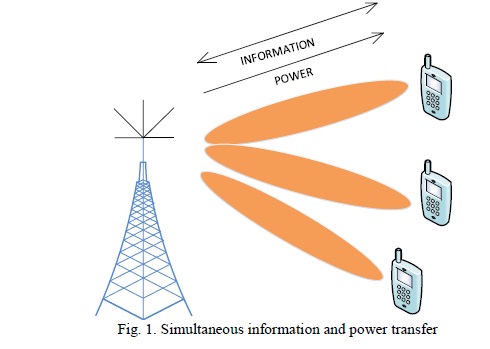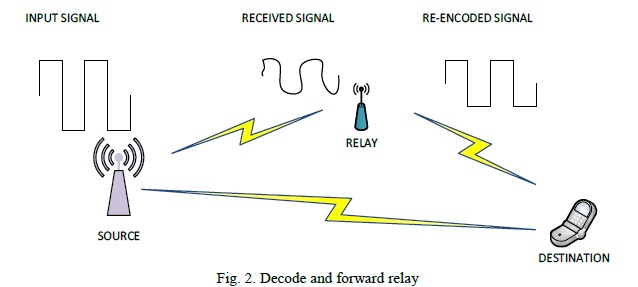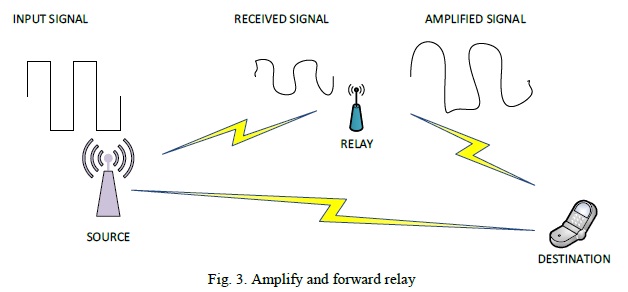





Published on Apr 02, 2024
With the evolution of communication technology, a corresponding requirement for optimization in energy consumption is also growing. With the emergence of 5G technology the importance of energy efficiency (EE) for wireless networks has been realized even more. The major concern is to improve EE without compromising on user experience. So in this paper, we address various energy issues and provide an analysis of various techniques which will be adopted in the 5G networks to improve the energy efficiency of the devices. We have focused our attention on the following areas to improve the energy efficiency which include EE improvement using radio access techniques like Simultaneous wireless energy and power transfer, EE improvement by use of Small Cells and Massive MIMO, EE improvement by using relays and D2D communication.
With the evolution of communication technology, a corresponding requirement for optimization in energy consumption is also growing. According to a survey the mobile operators are amongst the top energy consumers as well as their consumption is growing at a very fast rate especially with the deployment of 4G technology. The base station (BS) consumes a large part of the energy generating a large amount of electricity bill. Thus, not only from the operator’s but also from the consumer’s point of view, obtaining energy efficiency (EE) has significant economic benefits. It also has great ecological benefits and represents social responsibility in fighting climate change. So, there is an urgent need to purse energy efficiency along with optimal capacity and spectral efficiency when designing a wireless networks .
From the user’s point of view as well the energy efficiency in wireless communication is imperative. The need for energy efficient transmission originates from energy constrained networks like ad-hoc networks where wireless devices are battery powered so energy consumption must be minimized [2]. Thus, the cellular systems must be energy efficient, especially with the recent growing demand in mobile multimedia communication which has made the battery constraint a major issue. This has motivated optimization of energy for the use of mobile devices. With the emergence of 5G technology the importance of energy efficiency (EE) for wireless networks has been realized even more. The major concern is to improve EE without compromising on user experience. Energy Efficiency conventionally is defined as the measure of number of bits transmitted per joule of energy consumed
To make the upcoming 5G networks energy efficient, various techniques can be adopted. These techniques can be classified under three categories which are using energy efficient architectures or energy efficient resource allocation or using radio technologies which are energy efficient [4]. The following techniques are available:-
1. Energy-Efficient Architectures:
Optimization of cell size: large vs small cell deployment
Overlay source : microcell, picocell or femtocell
Relay and cooperative communications
2. Energy-Efficient Resource Management:
Joint power and resource allocation
SISO vs. MIMO with packet scheduling
3. Energy-Efficient Radio Technologies:
Heterogeneous network deployment (Multi-RAT)
SWIPT
These techniques have been discussed further for power optimization along with their integration with 5G network.
Recently due to greater demand of energy efficiency in wireless communication, there is a lot of interest of integrating energy harvesting technologies in wireless communication system. The most upcoming technology is WPT (wireless power transfer) where nodes charge their batteries from electromagnetic radiations. Strong signals increase power transfer but at the same time they also increase the amount of interference. This technique can be most useful in the case of sensor node or for the upcoming technology of Internet of Things in which the control signals will be used to charge the access point.
The future networks will overcome its problems of path loss with the use of MIMO, small cells and mm waves. The element used for this purpose is a Rectenna which converts microwave energy to direct current. This is achieved by splitting of the received signal to two orthogonal signals. SWIPT involves modification in the existing communication system.

There can be three scenarios where we use SWIPT:
Near field scenario: Power is transferred using inductor or capacitor coupling and upto tenths of watt can be transferred with a range of 1 m.
Far field Scenario: Power is transferred using directive power beaming with directive antennas upto mW and range of several meters.
Far field low power scenario: Power is transferred with RF power scavenging upto micro Watts with range of several km.
Now we concentrate ourselves on the far field scenario. For this the power signal received is split into two signals-one for energy harvesting and other used for information decoding.
Several methods are used to achieve this which are as follows:-
1. Time Switching: This is not a simultaneous processing technique as in one time slot RF signal is used either for information or for power transfer. It requires time synchronization.
2. Power Splitting: In this an RF signal is separated into two streams of different power levels using a power splitter. It is more complex and is used for critical information transfer.
3. Antenna Switching: In this technique an antenna element is switched for both decoding and rectifying. This can be used in MIMO systems. It uses some antennas with strongest channel paths for energy and rest for information.
4. Spatial Switching: This technique exploits multiple degrees of freedom (DoF) of interference channel.
The MIMO channel is transformed into parallel eigen value channels that can be used for either power or information transfer. This is a very promising technique for the next generation networks and has attracted the attention of many researchers. But there are still issues to be addressed for its practical implementation and integration with the existing networks as the present receivers need to be modified
Small cells is an umbrella term used for operator-controlled, low-powered and low-cost base stations (BS) operating in licensed spectrum. Small cells can be of different sizes depending on which they are classified as:-
Femto cells
Pico cells
Micro cells
They can have a centralized base station (BS) or remote radio heads which can be wired or wireless with core network. They reduce the distance between the user and BS hence also reducing the transmit power required to overcome the path loss hence improving the EE of both uplink and downlink. There are three basic access policies which can be used in each cell [6].
These are listed below:-
Closed access: In this scheme only the users present in a closed subscriber group can connect with each other.
Open access: In this scheme all users can connect with each other.
Hybrid access: In this scheme all users can connect with each other as well as priority is given to specific users.
There is a Small Cell Access (SCA) point which will be installed on buildings and will communicate with Base Station. The Mobile Stations located inside the building will only need to communicate to the SCA and not to the far located base station hence decreasing both the load and power requirement. Deployment of Small cells requires minimum changes in the current standard and can save a lot of user’s battery consumption. The trade-off between traffic off loading and energy consumption can be implemented through BS sleeping strategy.
Energy saving is a global trend today and the design philosophy must change accordingly. Facing this challenge, energy efficiency (EE) becomes increasingly important for mobile communications to prolong the life cycle of batteries. Power-control optimization for single antenna systems to operate on uplink code division multiple access (CDMA) Gaussian channels is tackled in the framework of game theory to maximize the individual energy efficiency of each user. Its counterpart for multi-carrier systems with orthogonal frequency-division multiplexing (OFDM) transmission, taking into account the circuit power consumption, link adaptation, and resource allocation. Massive MIMO is an evolving technology that has been upgraded from the current MIMO technology.
The Massive MIMO system uses arrays of antenna containing few hundred antennas which are at the same time in one time, frequency slot serving many tens of user terminals. In general, massive MIMO is an evolving technology of Next generation networks, which is energy efficient, robust, and secure and spectrum efficient [7]. Massive MIMO depends on spatial multiplexing, which further depends on the base station to have channel state information, both on the uplink as well as on the downlink. In case of downlink, it is not easy, but in case of uplink, it is easy, as the terminals send pilots. On the basis of pilots, the channel response of each terminal is estimated. In conventional MIMO systems, the base station sends the pilot waveforms to the terminals and based on these, the terminal estimate the channel, quantize it and feedback them to the base station.
This process is not viable for massive MIMO systems, especially in high mobility conditions because of two reasons. Firstly the downlink pilots from the base station must be orthogonal among the antennas, due to which the requirement of time, frequency slots for the downlink pilots increases with the increase in the number of antennas. So Massive MIMO systems would now require a large number of similar slots as compared to the conventional MIMO system. Secondly, as the number of base station antennas increases the number of the channel estimates also increases for each terminal which in turn needed hundred times more uplink slots to feedback the channel responses to the base station. A general solution to this problem is to work in Time Division Duplexing (TDD) mode and depend on the reciprocity amid the uplink and downlink channels.
With the growing trend of proximity-based applications, such as peer-to-peer file sharing and local multicasting and advertising, D2D communications have been proposed to improve local service flexibility and network throughput, and to support public safety service in case of lack of network coverage in 3GPP LTE-Advanced. In D2D communications, proximity users in cellular networks can transmit data directly to each other without going through the BS. Due to physical proximity, D2D communications can potentially provide proximity gain, reuse gain, and hop gain. Thus, D2D communications can significantly improve network SE and device EE.
Furthermore, D2D communications can provide more freedom for D2D users, as they can transmit data in three modes:
• Dedicated mode: D2D users directly transmit data by using the orthogonal resource of regular cellular users.
• Reusing mode: D2D users directly transmit data by reusing the resource of cellular users.
• Cellular mode: D2D users are treated as regular cellular users and communicate with each other through the BS in the standard way. Through proper mode selection, EE of both devices and the network can be significantly improved.
Relays in a wireless system can be considered as an “agent” of base station outside its cell coverage area. These wireless relays allow the mobile terminals to help in forwarding of information when they are neither the source nor the destination of the information involved. The concept of relays was introduced to increase the coverage area of transmission only but later it was realised that relaying can be applied in a wireless communication system to not only increase the coverage area but also increase the throughput of the network, system capacity as well as decrease the transmission power. The basic principle used in relaying is that in a relay assisted network, the mobile stations can receive signal from both base station (BS) as well as a Relay Node (RN) depending on which provides a better signal strength which mainly depends on the distance between them. This is what differentiates it from a normal wireless network in which each mobile station (MS) directly communicates with a base station [10]. Relaying splits longer paths into shorter ones by providing LOS communication and thus reducing the resulting total path loss. This consequently reduces the power required for transmission.
There exist three main relaying schemes:
Decode-and-Forward, Compress-and-Forward and Amplify-and-Forward.
The first two schemes were first proposed in the pioneer article by Cover and El-Gamal.
In this relaying scheme, the relay decodes the source message in one block and transmits the re-encoded message in the following block.
Compress-and-Forward (CF): In this relaying scheme, the relay quantizes the received signal in one block and transmits the encoded version of the quantized received signal in the following block.
Amplify-and-Forward (AF): In this relaying scheme, the relay sends an amplified version of the received signal in the last time-slot. Comparing with DF and CF, AF requires much less delay as the relay node operates timeslot by time-slot. Also, AF requires much less computing power as no decoding or quantizing operation is performed at the relay side.
So we can use Amplify and Forward relay in power constrained scenarios. Various relay selection policies are possible for different types of applications.

These are as follows:-
A reduced channel estimation overhead policy is provided for high mobility scenarios.
A delay minimization policy is given for delay critical applications.
A low power consumption policy for power-efficient communications.

So, to meet the objective of improving energy efficient, the policy for low power consumption for both of the base station and that of the relay node needs to be adopted.
In this paper, we have discussed the growing need for energy efficiency in the next generation networks. Further, we have gone through the various techniques which can be used in the future for optimizing the power of the network and the presented a summary of the work that has already been done to improve energy efficiency of network using these techniques. An energy efficient architecture for 5G networks is expected to include the use of relays, small cells, D2D communication and techniques such as Massive MIMO and SWIPT have been discussed in this paper. Thus, all these are expected to be integrated in the next generation networks to meet the goal of Energy Efficient Next generation networks.
[1] Strinati, E. Calvanese, and Laurent Hérault. "Holistic approach for future energy efficient cellular networks." e & i Elektrotechnik und Informationstechnik 127.11 (2010): 314-320.
[2] L. Correia, D. Zeller, O. Blume, D. Ferling, Y. Jading, I. Gódor, G. Auer, and L. Van Der Perre, “Challenges and enabling technologies for energy aware mobile radio networks,” IEEE Commun. Mag., vol. 48, no. 11,pp. 66–72, Nov. 2010.
[3] Santhi, K. R., et al. "Goals of true broad band's wireless next wave (4G-5G)."Vehicular Technology Conference, 2003. VTC 2003-Fall. 2003 IEEE 58th. Vol. 4. IEEE, 2003.
[4] Daquan Feng; Chenzi Jiang; Gubong Lim; Cimini, L.J., Jr.; Gang Feng; Li, G.Y.” A Survey of Energy-Efficient Wireless Communication”Communications Surveys & Tutorials, IEEE, Volume: 15, Issue: 1, 2013.
[5] Huang, K.; Larsson, E. “Simultaneous Information and Power Transfer for Broadband Wireless Systems” Signal Processing, IEEE Transactions, Volume: 61, Issue: 23, 2013
| Are you interested in this topic.Then visit the below page to get the full report |